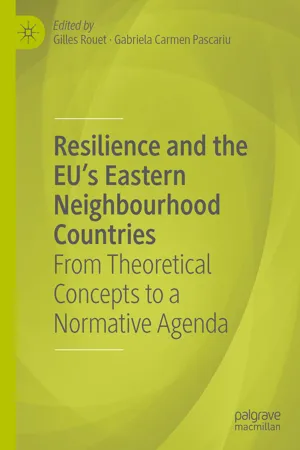1 European Union’s Eastern Neighbourhood: Geopolitical Context and the Normative Agenda
- 1.The ENP was mainly the result of external pressures, of a certain constraint, present on the regional geopolitical environment that has been restructured as a result of the EU’s own dynamics; as such, through successive expansions to the South and East (see also Howorth 2016), the EU aimed “to avoid new dividing lines in Europe”, by reducing the gaps between the regions inside the EU and those situated outside its immediate borders; furthermore, the EU’s Eastern neighbourhood was perceived as a threat to the Union’s security, as these countries (Russia included) did not clearly express a willingness to adopt a clear democratic path and a sustainable development model. Subsequently, the ENP has thus emerged as a reactive policy, its tools and methods being “imported” from its enlargement policy towards Central and Eastern Europe (i.e. Association Agreements, Action Plans, Financing, Market Liberalisation, Positive Conditionality). In this case, the Union sought to encourage and support, at the same time, the new neighbours to adopt the Western model of society and economy, but without offering institutional integration, thus “sharing everything with the Union, but institutions” (Prodi 2002). However, such a limitation has generated two opposite reactions in the neighbourhood: frustration in those countries that had European aspirations (such as Georgia, Moldova, or Ukraine), respectively, the perception of the EU as an oppressive power, with its specific conditionality; this view was particularly expressed by those countries with a more balanced approach towards the EU, that were rather oriented towards Russia (such as Belarus, Armenia and Azerbaijan).
- 2.When the ENP was launched, the EU was deemed strong and attractive enough for neighbouring countries so that it assumed a clearer external dimension. Moreover, the EU was also inclined to believe that its mechanism of positive conditionality, that had worked so well in the enlargement process, would be just as effective, despite lacking the promise of the EU’s accession itself. At the same time, the lack of a clear integration perspective, of limiting the neighbours’ access to the European common market highlighted the emerging of a certain “fatigue”, following the eastern enlargement of 2004–2007, which also partially indicated that the EU might have reached its geographical limit. In practice, these translated into a raising awareness of the existing vulnerabilities which have compelled the EU not to consider future enlargements, even in the case of those countries that would have opted for such a perspective.
- 3.By giving its own model a universal value, the EU has built its ENP around the idea that all neighbouring countries, including Russia, will automatically aspire and strive for the European model, so that the Union could assume the role of a transformative power in the region, without facing notable challenges in transferring to these countries its own rules, values, and institutions, in line with the acquis communautaire. In return for adopting the required reforms and policies that these countries have agreed to, thus promoting the “Europeanisation” phenomenon, the EU has offered financial support, strengthened cooperation and access to European programmes, security guarantees, as well as it has, overall, facilitated people’s mobility and access to European markets. However, in literature, the EU’s approach is being perceived as “Eurocentric” (Lehne 2014; Howorth 2016), “missionary” (Simionov and Tiganasu 2018, p. 137), or as an “intoxication with its own model” (Krastev and Leonard 2014).
